Commander Showdown — Vona vs Ayli vs Karlov

Triple Showdown
Back in June, I wrote Commander Showdown — Ayli vs Karlov, tackling the two lifegain-based Orzhov commanders, Ayli, Eternal Pilgrim and Karlov of the Ghost Council. Then Ixalan happened, throwing a new black-white lifegain commander into the mix. By now you're probably already familiar with her: it's Vona, Butcher of Magan.
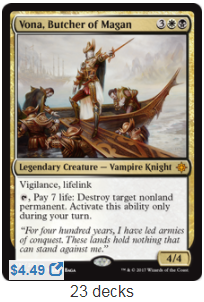
Yes, once again, we have an Orzhov commander that gains life and demolishes things she doesn't like. Thankfully, that's what the Commander Showdown series is here for---to compare and contrast commanders with similar abilities.
However, there is one enormous detail that sets Vona apart from Ayli, Eternal Pilgrim and Karlov of the Ghost Council. While her predecessors tout over 1,000 decks here on EDHREC, Vona scrapes a scant 23. That's right, of the fourteen current Orzhov commanders, Ayli and Karlov are #1 and #2, while Vona sits at #13, between unpartnered Ravos, Soultender and unpartnered Tymna the Weaver.
That's a significant difference, so for this week's Commander Showdown, let's see if we can't figure out what's going on. Is Vona underplayed, or has she been correctly relegated to the bottom of the heap?
A Quick Recap
In my previous Showdown between Ayli and Karlov, I came to the following conclusions:
"Ayli’s deck is decidedly gradual, not just because her abilities require setup, but because they’re powerful enough to remove anything in her way."
"Karlov weaponizes lifegain by turning himself into a Voltron. He can easily get to a power level that allows him to one-shot his opponents... However, this also means Karlov has many of the same weaknesses as other aggressive Voltron decks; if he’s not protected early, he may fall off a bit in the later half of the game, the half which Ayli very much looks forward to dominating."
In fact, I used the aforementioned Partner commanders, Ravos, Soultender and Tymna the Weaver, as a metaphor for each commander's strategy. Ayli prefers Ravos, since he provides important, incremental value over a long game. Karlov would rather play Tymna, who rewards him for his aggression. While they both turn their gain into pain, Ayli is more controlling, and Karlov basically likes to punch people.

Bearing that in mind, what can we make of Vona?
The Butcher of Magan
Let's start with her stats. Ayli and Karlov both cost two mana, but Vona, Butcher of Magan costs five. For that extra mana you get a 4/4 with vigilance and lifelink. That may not sound like much, but those abilities synergize with her next line of text: during your turn, you may also tap Vona, pay seven life, and destroy any nonland permanent. Seven life is a lot, but with Vona's lifelink, you can recoup some of that loss. If you power her up, you could potentially gain even more life than you pay!
More importantly, Vona's vigilance lets her have her cake and eat it too; you don't have to decide between attacking or using her ability, you can do both. While Vona is attacking, you can activate her tap ability mid-combat and destroy any blocker standing in her way. This is an old trick folks use with other vigilant creatures, like Adarkar Valkyrie and Razia, Boros Archangel.
Still, Vona has flaws. First, five mana is a lot more than two, which could make her deck slower than her predecessors. Second, her ability can only be used during your turn. It's not exactly sorcery speed, but it's close. This is a departure from both Ayli, Eternal Pilgrim and Karlov of the Ghost Council. They have restrictions on their abilities (namely, that you must gain enough life to activate them) but can still activate those abilities at any time. "Only during your turn" is a severe limitation.
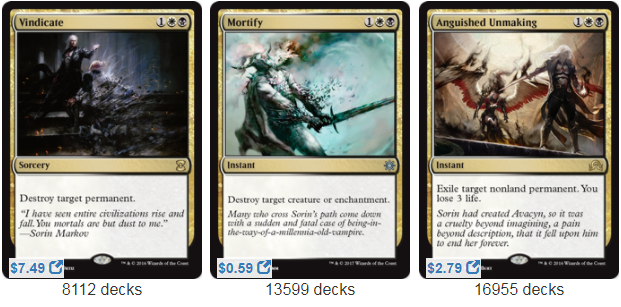
Take a look at the numbers on Orzhov's best removal spells. The famous Vindicate can destroy any permanent and currently sees play in a little over 8,000 decks. Compare this to Mortify, an instant that can only target creatures and enchantments. Vindicate is more flexible, yet Mortify sees play in over 13,000 decks, a full 5,000 more than Vindicate. True, Mortify is a less expensive and therefore more available card, which could skew those numbers. However, if we look at Anguished Unmaking, which is slightly more expensive than Mortify, we find that it sees twice as much play as Vindicate at 16,955 decks. Let's also not forget Utter End, which shows up in over 15,000 despite costing more mana!
Clearly, instant-speed removal is important in this format. The flexibility Vindicate offers you isn't as important as the flexibility instant speed offers you. Vindicate can do a good impression of a Stone Rain, but Mortify can do a good impression of a Fog by destroying an oncoming attacker, or by targeting someone's commander before they equip Lightning Greaves.
Which brings us back to Vona. Like Vindicate, her ability is hampered by its speed. Even though Karlov of the Ghost Council can only target creatures, his ability to do so at any time gives him an edge. As for Ayli, Eternal Pilgrim, her effect requires a sacrifice, but it's a cost worth paying for that flexibility. This leaves Vona in the dust, since she's not quite as quick on the draw as her competitors.
The EDH Law of Inertia
It's at this point that I'd like to discuss a theory I've been crafting about a phenomenon here on EDHREC. By now you've heard of the Precon Effect, a statistical bias that affects deckbuilding habits and influences the popularity of certain cards on this site. For your consideration, I submit another statistical law that messes with decks and popularity: The EDH Law of Inertia. It goes as follows:
EDH decks at rest will remain at rest unless acted upon by an overpowered commander.
In layman's terms, most players get attached to their decks. After putting so much work into them, we don't like to change things up. It would take a very, very compelling new reason to change that deck into something new. Thus, when a similar-ish commander is released, it has to be truly stellar to get us to switch over.
This phenomenon is apparent all over EDHREC. As mentioned before, Karlov and Ayli have thousands of decks to their names, while Vona is stuck in double-digits. Along the same vein, Prime Speaker Zegana boasts a proud 585 decks, while the newcomer Tishana, Voice of Thunder is trapped at 81. Mathas, Fiend Seeker is a new Mardu politics commander, but his 218 decks are overshadowed by Queen Marchesa's 1,586.
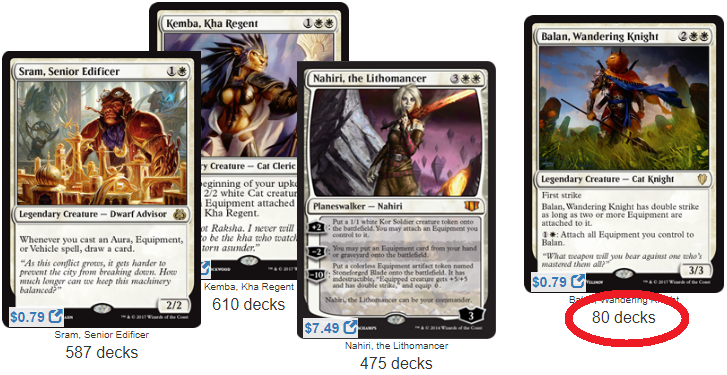
It doesn't stop there; Kemba, Kha Regent remains the most popular mono-white equipment commander with over 600 decks, tailed closely by Sram, Senior Edificer. 100 decks behind them, Nahiri, the Lithomancer makes a showing at 475, and far, far behind them all, the new Balan, Wandering Knight touts a mere 80. This is a real shame, since, by some players' estimations, Balan might actually be a more powerful commander than Kemba. (A mono-white equipment Commander Showdown is definitely on its way to determine whether that's true!)
In nearly every instance, newer commanders rarely overtake those that came before. The Scarab God is a solid 200 decks behind Gisa and Geralf. Sharuum the Hegemon still maintains a good lead over Sydri, Galvanic Genius, as does Niv-Mizzet, the Firemind over The Locust God. There's an argument to be made that some of these newer commanders are more powerful than their older counterparts, yet the new never surpass the old. That's the law of inertia at work; EDH decks at rest tend to stay at rest.
The Art of Breaking New Ground
This law has a second layer too. Take a look at the Top Commanders of All Time here on EDHREC. Of the 21 most-built commanders of all time, four of them are from the four-color Commander 2016 decks (Atraxa, Praetors' Voice, Breya, Etherium Shaper, Yidris, Maelstrom Wielder, and Kynaios and Tiro of Meletis). These commanders gave us, at long last, the ability to build four-color decks, something we'd never had before.
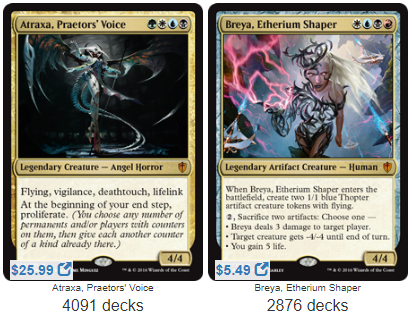
In fact, many of the Top Commanders of All Time gave us something we'd never had before. Nekusar, the Mindrazer was the first Grixis commander since Thraximundar, and Narset, Enlightened Master gave Jeskai a more competitive option than Zedruu the Greathearted and Ruhan of the Fomori. Queen Marchesa was the first non-aggressive Mardu commander to grace the format, and the long-reigning Oloro, Ageless Ascetic became the go-to option for Esper players that don't care about artifacts (and aren't competitive enough for Zur the Enchanter.) Even in Ixalan, the most popular commanders are Gishath, Sun's Avatar and Admiral Beckett Brass. Despite the limited pool of Dinos and Pirates, these commanders do something new, which makes them more enticing.
Meanwhile, Vona, Butcher of Magan arrived at a party that was already quite full. We have not one, but two prior commanders in her colors that gain life and exile things. Balan, Wandering Knight attempted to break into a field already crowded with equipment-based commanders. Tishana, Voice of Thunder is swimming up the stream Zegana already created. These commanders all attempted to fill a space that was already oversaturated. As a result, their popularity is low.
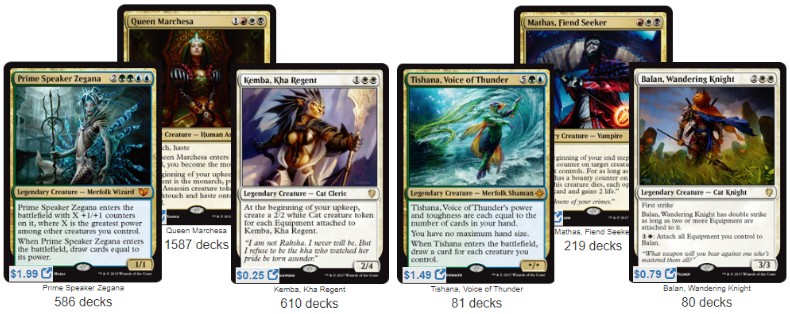
To put it simply, there's a strong correlation between a commander's uniqueness and its popularity. We players seem to care more that a commander do something new than something powerful. Trailblazer commanders, the ones that got there first, tend to claim a lot more territory than their subsequent followers. Players who wanted to build a lifegain-exile-stuff deck already had two bites at the apple before Vona came on the scene. If your interest wasn't piqued before, it probably wouldn't be now either. If you already did build one, Vona would have to absolutely knock your socks off to compel you to switch your deck over. Since she has some flaws, her resignation to the bottom of the barrel was inevitable. (Frankly, this law is so strong I'd actually wager that even if Vona had been strictly better than Ayli or Karlov, she'd still never be as popular as either of them.)
So, when trying to predict whether a commander will be popular, ask yourself, "Does this card do something we haven't seen before?" If the field is already oversaturated, odds are that commander won't see a lot of play. When using EDHREC, keep the Precon Effct in mind when evaluating individual cards, and the EDH Law of Inertia when evaluating commanders. Remember: 'less popular' is not the same thing as 'less powerful.'
Reaching a State of Nir-Vona
Back to business. Vona, Butcher of Magan has some glaring weaknesses when compared to Ayli and Karlov, but I don't think the main takeaway is that she's flat-out worse than them. As a matter of fact, I don't think it's fair to compare her to them at all. Though she appears similar to Ayli and Karlov at first blush, I think a more apt comparison is actually Licia, Sanguine Tribune and Selenia, Dark Angel.
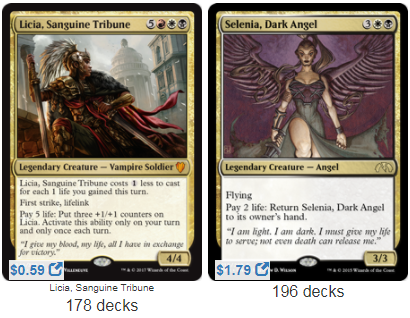
Licia hails from Commander 2017, and, like Vona, she uses life as an implement of destruction. By pumping herself up, she quickly snowballs into a powerful Voltron engine that uses lifelink to create her own fuel. This is exactly the kind of trick that Vona can use too. Paying seven life is a hefty cost, but if Vona is powered up enough, she can create more of that resource than she uses. Ayli and Karlov really only want their life totals to go up, but Licia takes the risk of a low life total for a potentially enormous payoff. This is an important lesson for Vona to learn.
The other comparison, Selenia, looks quite innocuous at first. Her stats aren't particularly impressive, and the ability to pay life to return to your hand isn't the kind of thing one usually looks for in a commander. Once again, don't be fooled. Selenia has some dastardly tricks up her sleeve. That ability of hers can actually be activated multiple times in a row. By holding priority, you can pay two life, or twenty, or thirty-eight, before she actually returns to your hand.
Why would you want to pay so much life? What does this have to do with Vona? Well, feast your eyes:
Nir-Vona
View on ArchidektThese aren't the kinds of cards you'd usually see in an Ayli or a Karlov deck. Sure, you have the standard Exsanguinate and Debt to the Deathless, and lifegain-doublers like Rhox Faithmender. Plus, no life-based deck would be complete without Sanguine Bond and Exquisite Blood (that is, unless you're a nicer person than me and you don't care much for that combo.)
The real stars, however, are these:
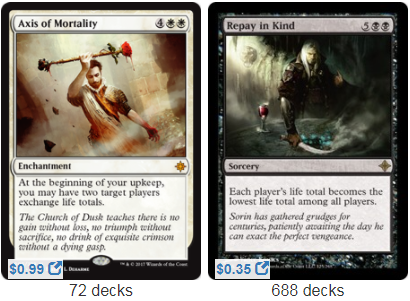
Repay in Kind and Axis of Mortality. This is why Selenia decks pay so much life; because you can give that loss of life away to your opponents. Since Vona pays so much life too, we can achieve similar results, with the added benefit of her destruction ability. Mutilate your own life total to ruin your opponents' boards, then swap your life total for a nice fresh one. Use Soul Conduit, Reverse the Sands, and Magus of the Mirror as backup You're literally draining the life out of other players. What could be more vampiric than that?
Taking a page out of Licia's book, I've also included a bunch of cards to power Vona up. Sunbond is just plain nasty, exponentially increasing Vona's power if your opponents don't find a way to deal with her. Sword of Feast and Famine and other such equipment are also quite useful. Vona can also be quite the little Voltron if she so chooses. This deck embraces the fact that your life total will be in constant flux, from 40 to 30 to 50 to 20 and back again. It's risky, but it's one heck of a roller coaster ride.
PS: If an effect sets your life total to a specific number, such as by exchanging your low life total with someone else's high life total via Reverse the Sands, that actually counts as you gaining life. Therefore Rhox Faithmender and other such effects will apply to it, so you actually gain way more life than you expected! Check out the Gatherer rulings for Rhox Faithmender (located lower on the page) for more details.
Recon Operation
Now for my absolute favorite card in the deck: Reconnaissance.
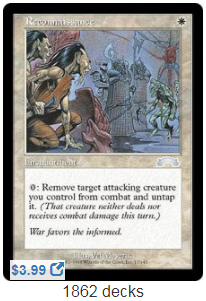
This card is broken. I don't mean that it's unfair; rather, I mean that it literally does not do what you think it should do. I'm actually not even comfortable talking about it, because it feels so wrong. In fact, you'll probably think I'm lying when I explain it. See that reminder text in parentheses? "That creature neither deals nor receives combat damage this turn." You can ignore it. No, really. That reminder text represents the way the card was originally supposed to work, but it no longer represents how the card functions today. This card can actually be used to untap your creatures after they have dealt combat damage.
How? Because of the way the Combat Phase works. There are five steps in the Combat Phase:
- Beginning of Combat Step
- Declare Attackers Step
- Declare Blockers Step
- Combat Damage Step
- End of Combat Step
Players can cast spells and activate abilities during each of these steps, which matters for a lot cards in the game. For example, Master Warcraft can be cast anytime before the Declare Attackers Step. When you block and sacrifice your Sakura-Tribe Elder before damage, you're doing that during the Declare Blockers Step. Blade of Selves creates tokens that exile themselves during the End of Combat Step. Technically, you could respond to that 'exile me' trigger before your creatures disappear (such as with a Sundial of the Infinite, so you'd get to keep those Myriad tokens permanently).
What do these steps have to do with Reconnaissance? Well, check out this rule about the End of Combat Step:
"Rule 511.3. As soon as the end of combat step ends, all creatures and planeswalkers are removed from combat. After the end of combat step ends, the combat phase is over and the postcombat main phase begins (see rule 505)."
In other words, if you attack with a creature, it is still considered to be an "attacking creature" during the End of Combat Step. It doesn't leave combat until that step is over. That means you can activate Reconnaissance during the End of Combat Step, even though you've already dealt damage. Vona can declare an attack, tap to use her ability, then untap with Reconnaissance during the end of combat, and tap to use her ability once again. It's counter-intuitive, nasty, and just plain weird, but as the rules currently stand, it works. In fact, you can pull off a similar trick with Maze of Ith, untapping your creature even after it hit someone.
If you take advantage of this weird rules loophole, I ask that you do it kindly. Explain this interaction before the game even begins. People will think you're trying to pull a fast one on them, and they'll be justified in thinking that, because it says on the card that the creature should deal no damage. The rules are just updated so often that sometimes cards no longer work as intended. Heck, check out Flying Carpet and then check out its oracle text. That's a difference if I ever saw one. To accommodate tens of thousands of cards, the rules have to be incredibly particular, and sometimes that creates loopholes. As long as this rule behaves the way it currently does, this is a valuable interaction Vona can take advantage of.
Cards to Consider
You've already seen the decklist above, but here are a few other standouts I think you should pay attention to if you're considering making your own Vona deck.
- Umbral Mantle: Untapping Vona mid-combat after using her ability is cool, and pumping her up on top of that is just awesome. See also: Thornbite Staff.
- Thousand-Year Elixir: Vona is hampered by summoning sickness, so you need as many ways to get around it as possible.
- Angelic Accord: Vona's a 4/4 with lifelink, and that's perfect to trigger this enchantment. Crested Sunmare doesn't get to keep the spotlight all to itself.
- Grand Abolisher: If there's anything I've learned playing EDH, it's that I like my turns to be mine. As long as you're stuck using Vona's abilities only on your turn, no one else should be able to butt in.
- Knight Exemplar: That's right, Vona, Butcher of Magan is a Knight. If only she'd also had the creature type "Hawk." Then she could have been a Vampire Knight Hawk. Get it? Vampire Knight Hawk? Vampire Nighthawk? No? Not funny? Well, in any case, the Exemplar is basically a second copy of Bastion Protector and that's neat.
No Pain, No Gain
I apologize if this "Vona vs Ayli vs Karlov" Showdown didn't contain enough Ayli and Karlov. If you'd like to hear more of my opinions about them, you can check out their previous Showdown. In truth, the comparison to Ayli and Karlov was a bit of a ruse. Merely looking at Vona, it's easy to draw an immediate comparison to Ayli and Karlov, but Vona reminds us to look past our first impressions and look for deeper details.
She also reminds us to look out for EDH Inertia, which dilutes the popularity of new commanders that don't have entirely original abilities. Have you experienced this effect yourself? Are there powerful legendary creatures out there that should be more popular, but constantly get overshadowed by pre-existing commanders? Better yet, what newer commanders did overtake their predecessors? Let me know your thoughts below, as well as which commanders you'd like to see in a future Commander Showdown!
Til next time!
EDHREC Code of Conduct